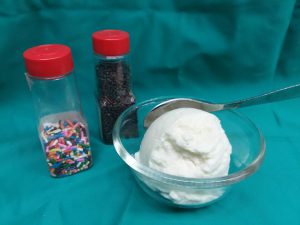July is one of my favorite months of the year. Summer is in full swing, school is out, temperatures are soaring, and we celebrate Independence Day, as well as my birthday! While all those things are great, my favorite part about the month is celebrating National Ice Cream Month all month long! Who wouldn’t love a cold, sweet treat on a hot, summer day?
Did you know that one 1/2 cup serving of regular ice cream is considered a good source of calcium and phosphorous, containing 10% of the recommended daily value? While ice cream can be part of a balanced diet, its high calorie and fat content are something to consider. Ice cream is good in moderation, something I know I struggle with.
One of my favorite things about ice cream is the options are endless. Not only are there numerous flavors to choose from, but there are other options for how it can be made or served. “Add-ins” such as berries, chocolate sauce, sprinkles, and whipped cream can change how the base ice cream tastes. Some of the most popular flavors, such as vanilla, chocolate, cookie dough, strawberry, butter pecan, etc., do not need any add-ins though.
Types of ice cream also can be broken down into different categories:
- Regular ice cream is a frozen food product made from dairy products with at least 10% milk fat.
- Light ice cream contains at least 50% less fat or 33% fewer calories than regular ice cream.
- Low-fat ice cream contains no more than 3 grams of fat per serving.
- Nonfat ice cream contains less that 0.5 gram of fat per serving.
- Frozen custard, also known as French ice cream, contains a minimum of 10% milk fat as well as 1.4% egg yolk solids.
- Sherbets have a milk fat content only between 1-2%.
- Sorbet, also known as water ices, are similar to sherbet, but do not contain dairy.
- Frozen yogurt has a mixture of dairy ingredients such as milk or nonfat milk that has been cultured, as well as other ingredients for sweetening and flavoring.

Enjoy a scoop of ice cream in honor of National Ice Cream Month.
Photo source: UF/IFAS Northwest District
Since the kids are home from school, I am always looking for activities for them. Check out the recipe and instructions below for how to make your own ice cream in a bag at home!
Ingredients:
- 3 Zip-top bags: 2 quart-size and 1 gallon-size
- ¼ c. cream
- ¼ c. milk
- 1 Tbsp. sugar
- 3/4 tsp. vanilla extract
- 4-5 c. ice
- 1/3 c. salt (rock salt or large granules works the best)
- Toppings of your choice (sprinkles, chocolate syrup, fruits, whipped cream, etc.)
Directions:
- Bag it! In a quart Zip-top bag, combine cream, milk, sugar and vanilla. Push out excess air and seal. (Double bag it to avoid spillage)
- Ice it! Add the ice and salt into the gallon zip-top bag. Then place the smaller, sealed bag into the ice.
- Shake it! Seal the bag and shake vigorously, 7 to 10 minutes. Do this until the ice cream has hardened. The more you shake, the quicker it hardens.
- Remove it! Remove the smaller bag from the big bag. Throw the big bag away.
- Top it! Either eat the ice cream out of the bag or spoon it into a bowl. Add your favorite toppings and enjoy!
Source:
https://fsi.colostate.edu/ice-cream/
- The 8 Pillars of Health and Wellness - November 21, 2025
- Safe Summer Cooking: The Importance of Proper Cooking Temperatures - September 5, 2025
- Protecting Your Family’s Skin: The Importance of Sun Safety - March 1, 2025


